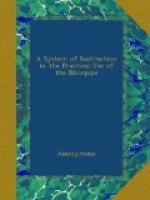Tungstic acid gives a dark yellow clear bead while hot, but is opaque and yellow when cold.
The oxides of manganese give to the soda bead a fine characteristic green color. This is the case with a very small quantity. This reaction is best exhibited on platinum foil.
Oxide of cobalt gives to the bead while hot a red color, which, upon being cooled, becomes grey.
The oxide of copper gives a clear green bead while hot.
The oxide of lead gives a clear colorless bead while hot, which becomes, upon cooling, of a dirty yellow color and opaque.
* * * * *
The following metals, when they are fused with soda on charcoal, in the flame of reduction, produce volatile oxides, and leave an incrustation around the assay, viz. bismuth, zinc, lead, cadmium, antimony, selenium, tellurium, and arsenic.
Bismuth, under the reduction flame, yields small particles of metal, which are brittle and easily crushed. The incrustation is of a flesh color, or orange, when hot, but gets lighter as it cools. The sublimate may be driven about the charcoal from place to place, by either flame, but is finally dissipated. While antimony and tellurium, in the act of dissipation, give color to the flame, bismuth does not, and may thus be distinguished from them.
Zinc deposits an incrustation about the assay, which is yellow while hot, but fades to white when cold. The reduction flame dissipates this deposit, but not that of oxidation. All the zinc minerals deposit the oxide incrustation about the assay, which, when moistened with a solution of cobalt and heated, changes to green.
Lead is very easily reduced, in small particles, and may be easily distinguished by its flattening under the hammer, unlike bismuth. It leaves an incrustation around the assay resembling that of bismuth, in the color of it, and in the peculiar manner in which it lies around the assay.
Cadmium deposits a dull reddish incrustation around the assay. Either of the flames dissipate the sublimate with the greatest readiness.
Antimony reduces with readiness. At the same time it yields considerable vapor, and deposits an incrustation around the assay. This deposit can be driven about on the charcoal by either of the flames. The flame of reduction, however, produces the light blue color of the antimony.
Selenium is deposited on the charcoal as a grey metallic-looking sublimate, but sometimes appearing purple or blue. If the reduction flame is directed on this deposit, it is dissipated with a blue light.
Tellurium is deposited on the charcoal as a white sublimate, sometimes changing at the margin to an orange or red color. The oxidation flame drives the deposit over the charcoal, while the reduction-flame dissipates it with a greenish color.
Arsenic is vaporized rapidly, while there is deposited around the assay a white incrustation of arsenious acid. This deposit will extend to some distance from the assay, and is readily volatilized, the reducing flame producing the characteristic alliaceous color.




